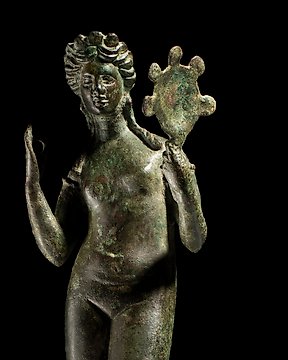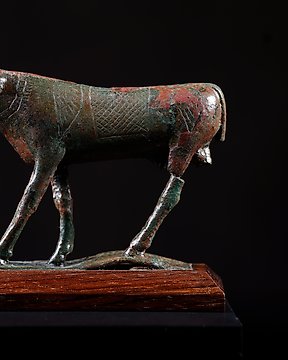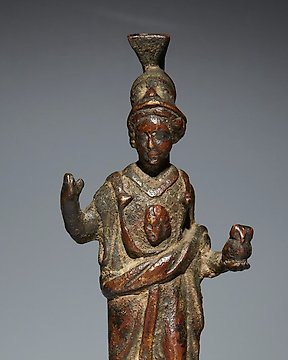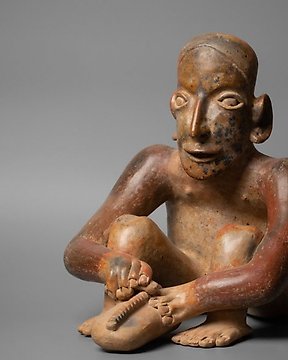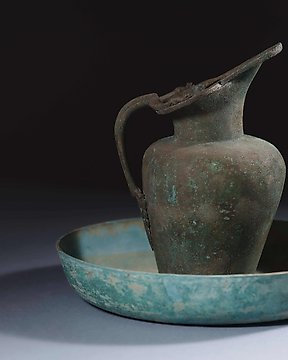Wunderbares Stück. Alles wie beschrieben. Hervorragender Kontakt.
Ver traducciónibérico Bronce Figura Votiva Lobo. Siglo V-I a.C. 6,2 cm L. Con Licencia de Exportación Española.
N.º 84871733

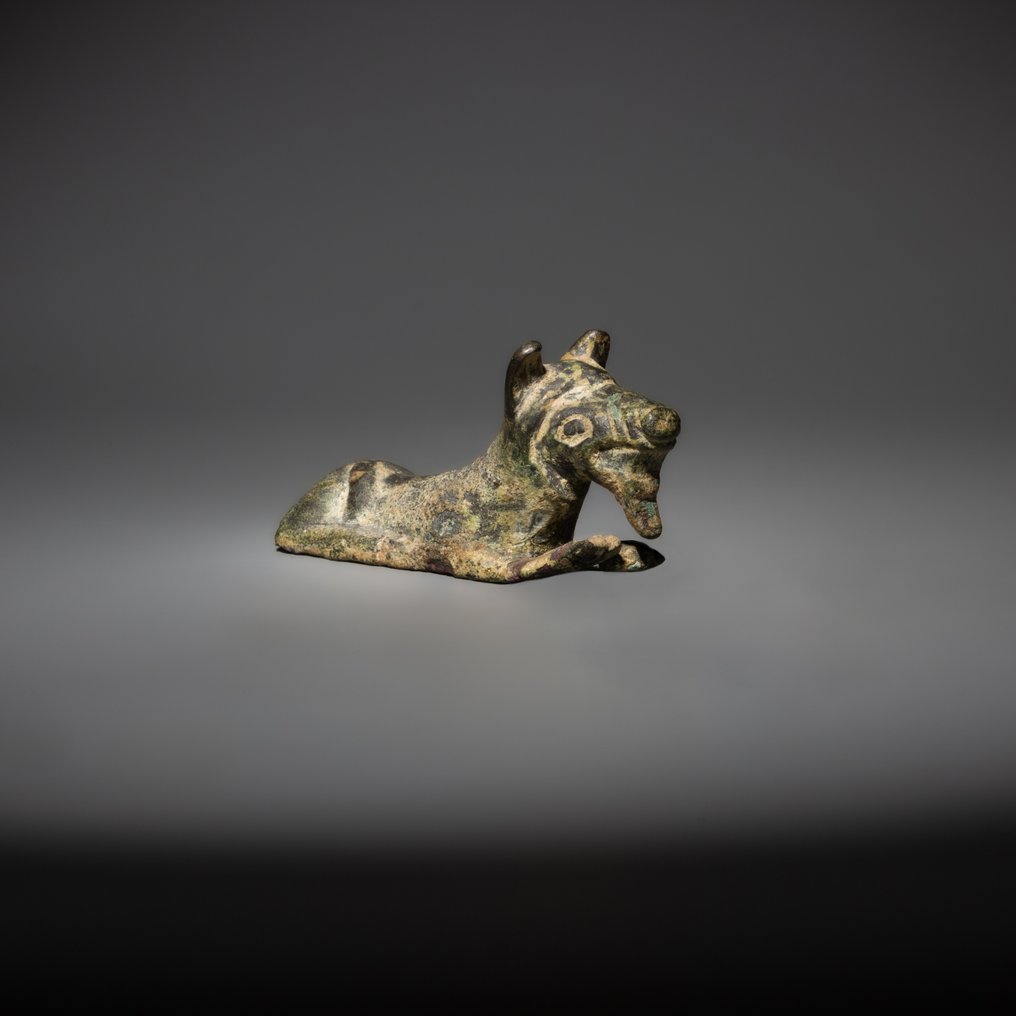
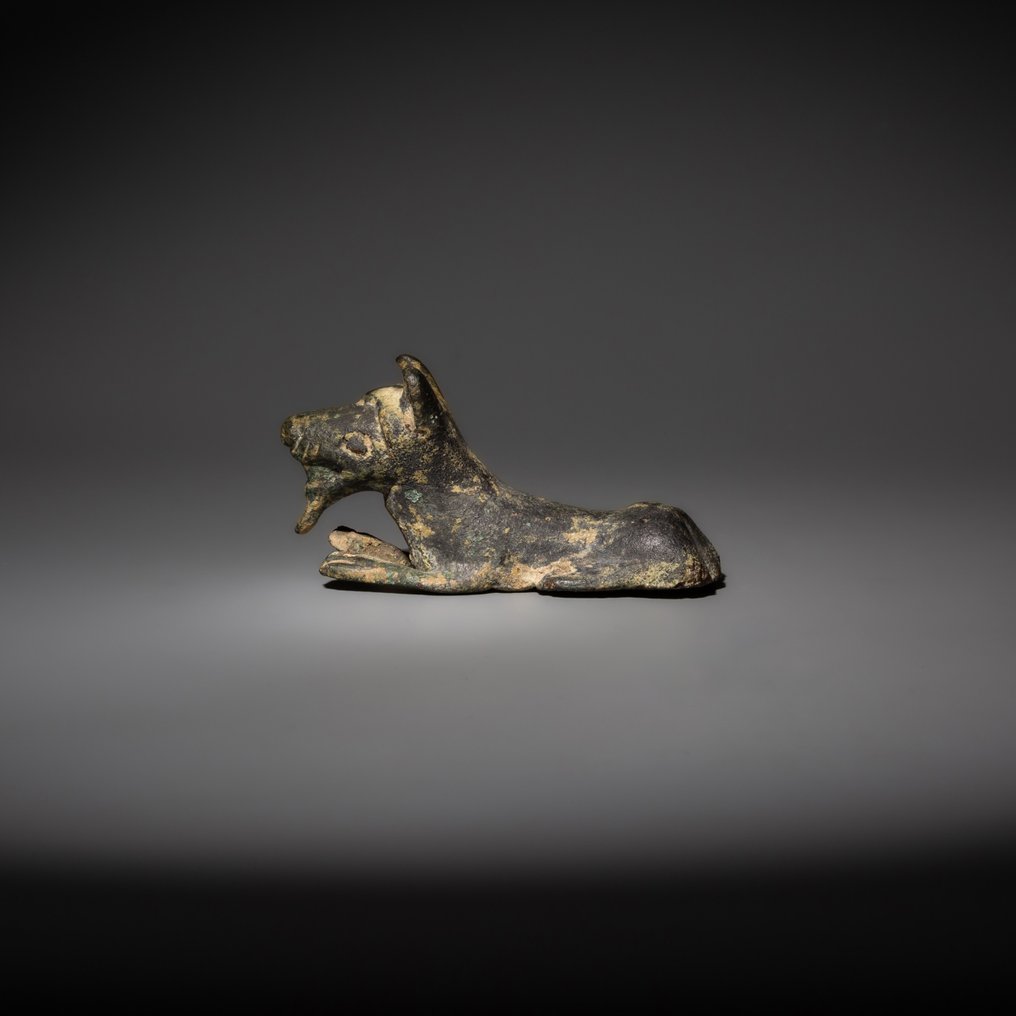


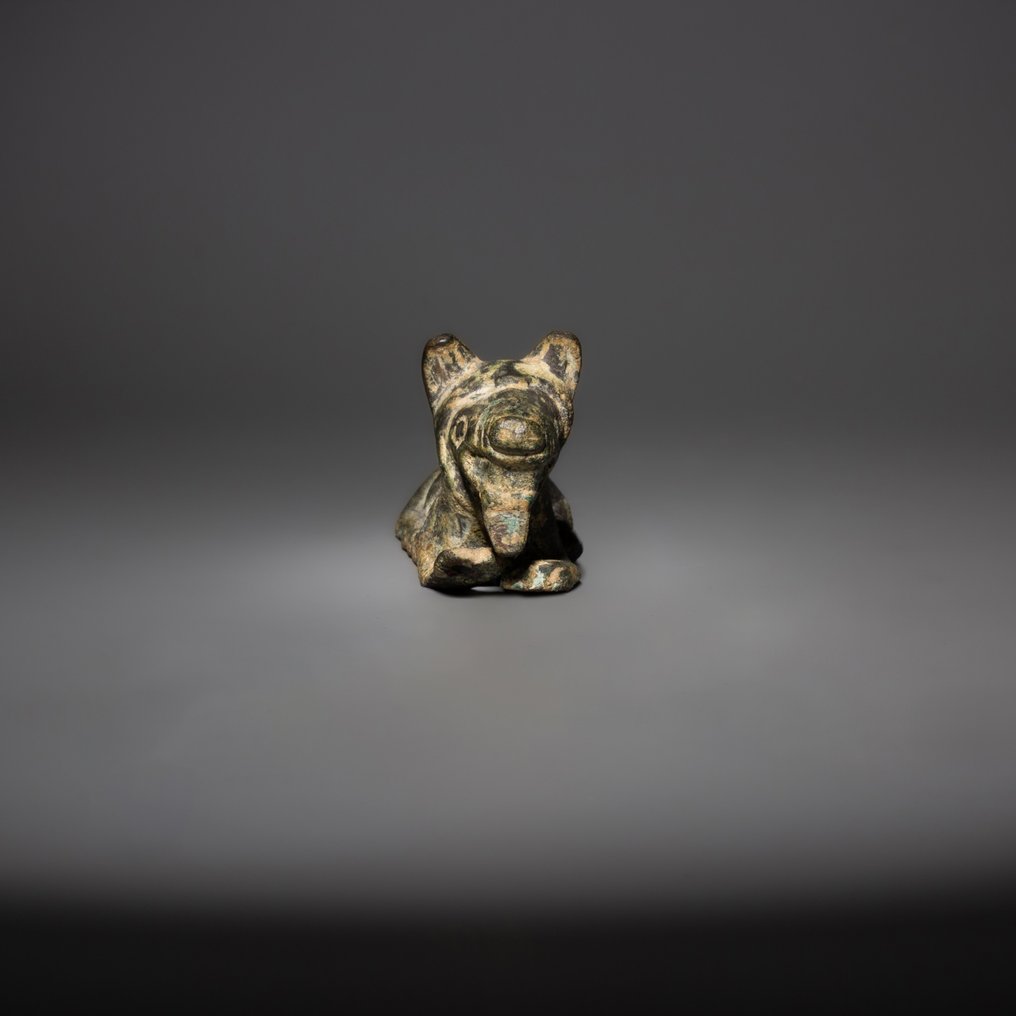
Votive Wolf Figure.
Iberian, 5th - 1st century BC.
Bronze
6.2 cm L.
PROVENANCE: Private collection, Munich, Germany. Acquired from Titiana & Slavey Art Numis, Munich, copy of the bill of sale is attached.
Private collection, Estepona, Malaga.
CONDITION: Good condition, intact.
DESCRIPTION:
Iberian bronze statuette, worked in a rounded bulk, representing the figure of a wolf lying down in a resting position, with its hind legs bent and its front legs stretched out in front of it. The head is large, with the ears erect and alert, large oval eyes and a wrinkled muzzle as it draws back to open its mouth. The open jaws show something inside, which is difficult to distinguish. The realism of the movement, reflecting the artist's direct knowledge of nature, contrasts with the general schematic nature of Iberian art, especially in votive offerings.
Among the Iberians, the wolf had a funerary symbolism, with an apotropaic meaning due to its ferocity. It was also linked to night, war and death, which is why its representation is not uncommon in important pieces such as the chariot top from Cortijo de Maquiz (fig. 1), or in votive objects offered as votive offerings (fig. 2). The production of votive offerings in the form of animals, both domestic and wild (fig. 3), was also common, so this could be the function of this figurine, which would have been deposited in a shrine as a propitiatory offering.
The name Iberian refers to the human groups that inhabited the Mediterranean and southern areas of the Iberian Peninsula between the 4th century BC and the Romanisation of the area, until the 1st century BC. The Iberian culture therefore extended over a wide area stretching from Andalusia to Languedoc in southern France. It was a creative, advanced civilisation, sustained by a society organised around fortified hilltop cities, strongly hierarchical and linked by trade with the Greeks and Phoenicians.
The Iberians developed their own art, with a marked personality and, at the same time, permeable to Eastern influences, especially those of classical and Hellenistic Greece. Indissolubly linked to religion, Iberian art is related to funerary beliefs and the development of sanctuaries, which had a dual function as a sacred place and as a border marker. The interpretation of the works of art found in Iberian necropolises and sanctuaries allows us to learn about the beliefs of this people, their legends and even the personal religiosity of individuals.
Particularly noteworthy are the votive offerings, one of the most characteristic manifestations of Iberian culture, generally made in lost-wax bronze, although they have also been preserved in stone and terracotta. These are small statuettes, around 10 cm in height (the largest are no more than 25 cm), commissioned by high-ranking figures to be offered in the sanctuaries in exchange for protection, well-being, health or prosperity. In fact, most of them have been found in the cave sanctuaries of Despeñaperros, Sierra Morena and Castellar, in Jaén, as well as in La Luz, Murcia. Although they are a very heterogeneous group, they are generally stylised images of men or women in a reverential attitude, with exaggerated features or sexual organs (in the case of those related to fertility), although there are also known votive offerings representing horsemen, horses and other animals and also parts of the body, the latter related to the healing of illnesses or specific limbs.
BIBLIOGRAPHY:
- ARANEGUI GASCÓ, C. Los íberos ayer y hoy. Arqueologías y culturas. Marcial Pons Historia. 2017.
- BERMEJO TRIADO, J. Breve historia de los íberos. Nowtilus. 2010.
- PRADOS TORREIRA, L. Exvotos ibéricos de bronce del Museo Arqueológico Nacional. Ministerio de Cultura. 1992.
- QUESADA SANZ, F. “Los íberos y la cultura ibérica”, en CELESTINO PÉREZ, S., coord., La protohistoria en la Península Ibérica. Akal. 2017.
- RUEDA GALÁN, C.; HERRANZ SÁNCHEZ, A.B.; BELLÓN RUIZ, J.P., coord. Exvotos íberos. Paisajes sagrados, peregrinaciones y ritos. Universidad de Jaén. 2021.
- RUIZ, A.; MOLINOS, M. Los íberos. Análisis arqueológico de un proceso histórico. Grijalbo. 1993.
- TARRADELL, M. Arte ibérico. Polígrafa. 1968.
- VV.AA. Revista de Estudios Ibéricos. Universidad Autónoma de Madrid. 1994-1998.
PARALLELS:
Fig. 1 Chariot finial with a wolf's head. Cortijo de Maquiz, Mengíbar (Jaén), 4th c. BC Bronze. National Archaeological Museum, Madrid, inv. 1970/54/1.
Fig. 2 Vase fragment (votive offering) with a wolf's head. El Amarejo, Bonete (Albacete), 4th-3rd c. BC. Polychrome pottery. Museum of Albacete, inv. CE09868.
Fig. 3 Bear votive offering. Sanctuary of Collado de los Jardines, Santa Elena (Jaén), 4th-1st century BC. Bronze. National Archaeological Museum, Madrid, inv. 29381.
Notes:
- The piece includes authenticity certificate.
- The piece includes Spanish Export License (Passport for European Union) - If the piece is destined outside the European Union a substitution of the export permit should be requested, can take between 1-2 weeks maximum.
- The seller guarantees that he acquired this piece according to all national and international laws related to the ownership of cultural property. Provenance statement seen by Catawiki.
El vendedor y su historia
Votive Wolf Figure.
Iberian, 5th - 1st century BC.
Bronze
6.2 cm L.
PROVENANCE: Private collection, Munich, Germany. Acquired from Titiana & Slavey Art Numis, Munich, copy of the bill of sale is attached.
Private collection, Estepona, Malaga.
CONDITION: Good condition, intact.
DESCRIPTION:
Iberian bronze statuette, worked in a rounded bulk, representing the figure of a wolf lying down in a resting position, with its hind legs bent and its front legs stretched out in front of it. The head is large, with the ears erect and alert, large oval eyes and a wrinkled muzzle as it draws back to open its mouth. The open jaws show something inside, which is difficult to distinguish. The realism of the movement, reflecting the artist's direct knowledge of nature, contrasts with the general schematic nature of Iberian art, especially in votive offerings.
Among the Iberians, the wolf had a funerary symbolism, with an apotropaic meaning due to its ferocity. It was also linked to night, war and death, which is why its representation is not uncommon in important pieces such as the chariot top from Cortijo de Maquiz (fig. 1), or in votive objects offered as votive offerings (fig. 2). The production of votive offerings in the form of animals, both domestic and wild (fig. 3), was also common, so this could be the function of this figurine, which would have been deposited in a shrine as a propitiatory offering.
The name Iberian refers to the human groups that inhabited the Mediterranean and southern areas of the Iberian Peninsula between the 4th century BC and the Romanisation of the area, until the 1st century BC. The Iberian culture therefore extended over a wide area stretching from Andalusia to Languedoc in southern France. It was a creative, advanced civilisation, sustained by a society organised around fortified hilltop cities, strongly hierarchical and linked by trade with the Greeks and Phoenicians.
The Iberians developed their own art, with a marked personality and, at the same time, permeable to Eastern influences, especially those of classical and Hellenistic Greece. Indissolubly linked to religion, Iberian art is related to funerary beliefs and the development of sanctuaries, which had a dual function as a sacred place and as a border marker. The interpretation of the works of art found in Iberian necropolises and sanctuaries allows us to learn about the beliefs of this people, their legends and even the personal religiosity of individuals.
Particularly noteworthy are the votive offerings, one of the most characteristic manifestations of Iberian culture, generally made in lost-wax bronze, although they have also been preserved in stone and terracotta. These are small statuettes, around 10 cm in height (the largest are no more than 25 cm), commissioned by high-ranking figures to be offered in the sanctuaries in exchange for protection, well-being, health or prosperity. In fact, most of them have been found in the cave sanctuaries of Despeñaperros, Sierra Morena and Castellar, in Jaén, as well as in La Luz, Murcia. Although they are a very heterogeneous group, they are generally stylised images of men or women in a reverential attitude, with exaggerated features or sexual organs (in the case of those related to fertility), although there are also known votive offerings representing horsemen, horses and other animals and also parts of the body, the latter related to the healing of illnesses or specific limbs.
BIBLIOGRAPHY:
- ARANEGUI GASCÓ, C. Los íberos ayer y hoy. Arqueologías y culturas. Marcial Pons Historia. 2017.
- BERMEJO TRIADO, J. Breve historia de los íberos. Nowtilus. 2010.
- PRADOS TORREIRA, L. Exvotos ibéricos de bronce del Museo Arqueológico Nacional. Ministerio de Cultura. 1992.
- QUESADA SANZ, F. “Los íberos y la cultura ibérica”, en CELESTINO PÉREZ, S., coord., La protohistoria en la Península Ibérica. Akal. 2017.
- RUEDA GALÁN, C.; HERRANZ SÁNCHEZ, A.B.; BELLÓN RUIZ, J.P., coord. Exvotos íberos. Paisajes sagrados, peregrinaciones y ritos. Universidad de Jaén. 2021.
- RUIZ, A.; MOLINOS, M. Los íberos. Análisis arqueológico de un proceso histórico. Grijalbo. 1993.
- TARRADELL, M. Arte ibérico. Polígrafa. 1968.
- VV.AA. Revista de Estudios Ibéricos. Universidad Autónoma de Madrid. 1994-1998.
PARALLELS:
Fig. 1 Chariot finial with a wolf's head. Cortijo de Maquiz, Mengíbar (Jaén), 4th c. BC Bronze. National Archaeological Museum, Madrid, inv. 1970/54/1.
Fig. 2 Vase fragment (votive offering) with a wolf's head. El Amarejo, Bonete (Albacete), 4th-3rd c. BC. Polychrome pottery. Museum of Albacete, inv. CE09868.
Fig. 3 Bear votive offering. Sanctuary of Collado de los Jardines, Santa Elena (Jaén), 4th-1st century BC. Bronze. National Archaeological Museum, Madrid, inv. 29381.
Notes:
- The piece includes authenticity certificate.
- The piece includes Spanish Export License (Passport for European Union) - If the piece is destined outside the European Union a substitution of the export permit should be requested, can take between 1-2 weeks maximum.
- The seller guarantees that he acquired this piece according to all national and international laws related to the ownership of cultural property. Provenance statement seen by Catawiki.
El vendedor y su historia
- 752
- 7
- 0
Extremely rapid courrier service from Barcelona to Flanders, picture was nicely and carefully packaged. Muchas gracias!
Ver traducciónVery fine specimen! Thanks.
Ver traduccióngoede foto's, goede omschrijving, goed verpakt en snel verzonden.
Ver traducciónmolto bello tutto ok
Ver traducciónPezzo come da descrizione, davvero notevole. Venditore molto consigliato in quanto gentile e disponibile. spedizione molto veloce. Ottimo!
Ver traducciónVenditore davvero ottimo e gentile. Merce come da descrizione, spedizione veloce. Ottimo l'avere certificato di autenticità.
Ver traducciónUn 100 como empresa un 100 como envío . Empresa muy especial con mucha exquisitez en todos los productos y en personal . Muchas gracias
Ver traducciónAll well! Thanks.
Ver traducciónVery nice and fine cut little jewel! Well packed too! Thanks!
Ver traducciónnice piece and very fast shipping!
Ver traducciónEs una maravilla de moneda, donde se le nota los pasos de los años y me encanta. Servido muy rápido y bien empaquetado. Con su certificación. Qué más se puede pedir?
Ver traducciónSnelle en correcte levering, alleen was de verpakking voor het schilderij niet stevig genoeg.
Ver traducciónHerzlichen Dank!
Ver traducciónAll OK and with very fast shipping.
Ver traducciónPrachtig schilderij. Zo blij mee. Zeer nette verkoper en zeer snelle levering.
Ver traducciónperfect ! very fast and high quality delivery !
Ver traducciónAll well! Thanks.
Ver traducciónVendeur très professionnel, top +++×
Ver traducciónPhotos trop contrastées pour bien percevoir les défauts, mais ces défauts étaient visibles pour autant. Le "Bon état" est trompeur. Sinon, envoi rapide et correctement emballé. Frais de port exagérés.
Ver traducciónGreat communication, delivery and product. Came with a well made certificate of authenticity and good packaging. Overall very happy with the purchase! Delivery is a bit expensive, but I recommend it
Ver traducciónMagnifique témoin du passé, envoyé avec tous les justificatifs, impeccable. Encore une fois très satisfait, un grand merci
Ver traducciónThank you for the Special offer and the fast shipping of this excellent piece of art!
Ver traducciónvery good description of the object, very good price for this rare item,. Fast sending (has been at my place 2 days after buying!). Definitely would buy again.
Ver traducción- 752
- 7
- 0
Wunderbares Stück. Alles wie beschrieben. Hervorragender Kontakt.
Ver traducciónAviso legal
El vendedor garantiza y puede probar que el objeto ha sido obtenido legalmente. Catawiki ha informado al vendedor de que tenía que proporcionar la documentación exigida por las leyes y reglamentos de su país de residencia. El vendedor garantiza que tiene derecho a vender/exportar este objeto. El vendedor le proporcionará al comprador toda la información disponible sobre la procedencia del objeto. El vendedor garantiza que se tramitarán todos los permisos necesarios. El vendedor informará inmediatamente al comprador de cualquier retraso en la obtención de dichos permisos.
El vendedor garantiza y puede probar que el objeto ha sido obtenido legalmente. Catawiki ha informado al vendedor de que tenía que proporcionar la documentación exigida por las leyes y reglamentos de su país de residencia. El vendedor garantiza que tiene derecho a vender/exportar este objeto. El vendedor le proporcionará al comprador toda la información disponible sobre la procedencia del objeto. El vendedor garantiza que se tramitarán todos los permisos necesarios. El vendedor informará inmediatamente al comprador de cualquier retraso en la obtención de dichos permisos.


